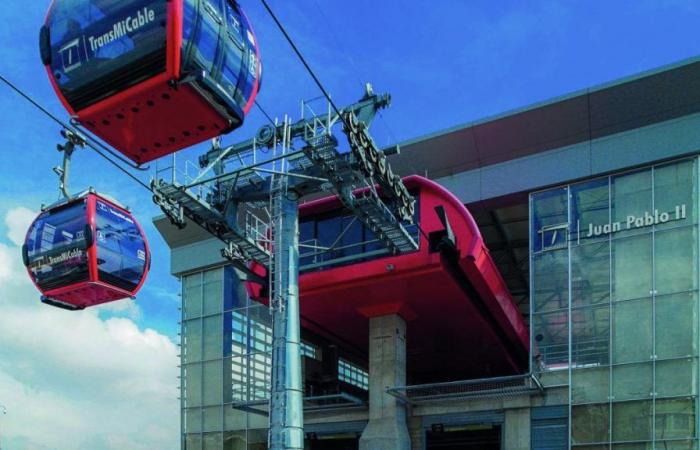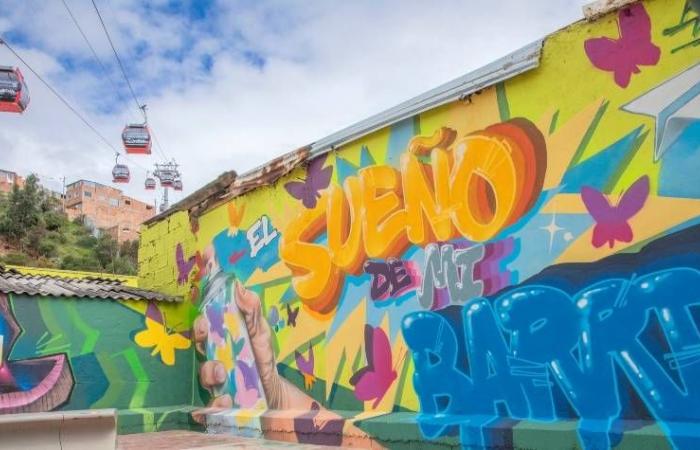The country is shocked with the fall more than 10 meters high from a cabin on line K of the Medellín Metrocablewhich left one man dead and 21 people injured.
According to the criteria of
“A cable car that came down from that sector, before entering Santa Lucía, hits another cabin, we still don’t know why that hit occurs, and that is what caused the fall,” said Tomás Elejalde, director of the cable car, on Wednesday. Medellín Metro.
Although the causes are still under investigation, citizens have doubts about how these overhead cables are handled both in the capital of Antioquia and in other cities. In Bogotá, for example, this means of transportation already exists in Ciudad Bolívar and more lines are being built in San Cristóbal and Potosí.
The TransMiCable system has 3.25 kilometers of coverage, 4 stations and 163 cabins.
Photo:Rodrigo Sepúlveda. EL TIEMPO Archive
After the event, TransMilenio reported that the city’s southern cable “has a robust control system, redundant sensors that monitor the operation of all components and a high-precision system in stations and towers that monitor the passage at all times. of cabins and their behavior under climatic or external conditions”.
TransMiCable also has constant execution of maintenance activities by the operator, which follow the manufacturer’s requirements and corresponding standards.
He added that, if differences occur in the measurement of any parameter, the system activates alerts preventively so that a condition verification is carried out and thus guarantee the safety of users.
“TransMiCable also has constant execution of maintenance activities by the operator, which follow the manufacturer’s requirements and corresponding standards,” the company added.
It should be noted that The TransMiCable system has 3.25 kilometers of coverage, 4 stations, 163 cabins and has an average of 638,000 monthly validationswhich is equivalent to 24,000 validations in one business day.
This is the treatment of the TransMiCable
In inter-administrative contract 2671 of 2023 between TransMilenio and La Rolita, the entity that operates the cable in Ciudad Bolívar, it is determined that permanent compliance with European quality standards is mandatory for this type of systems.
In addition, the operator (La Rolita) must maintain specialized Computer-Assisted Maintenance Management Software (CMMS) or Specialized Maintenance Software, which may be requested by TransMilenio at any time.
TransMicable.
Photo:Bogota City Hall
The contract also describes the cable monitoring and maintenance activities, which may be daily, monthly, annual or every few years.
The murals are one of the attractions that emerged next to the cable.
Photo:TransMilenio
In the case of daily reviews, A test run must be carried out to verify the proper functioning of the cable supports; the absence of obstacles on the line structures; the condition and absence of obvious irregularities or damage to all vehicles; the absence of modifications to the environment such as falling stones and avalanches, among other points.
On the other hand, every month the operator evaluates aspects such as the joints between cables (splices); the reciprocal position of cables and rails in the coupling and decoupling areas; the entry, exit and passage of vehicles at the station and the brakes and their fittings.
The document also talks about a more in-depth annual review of all aspects: civil engineering constructions, mechanical devices, electrical devices, security, surveillance and signaling devices and vehicles.
Some elements have to be changed approximately every five years, so even closure of the system must be carried out. A year ago, in June 2023, the service was disabled precisely due to this maintenance.
Users complain about constant stops
Several TransMiCable users have reported that the system in recent months has begun to stop at various points along the routewhich would have gone from taking 13 minutes to taking half an hour or more.
The stops generated in the operation of the TransMiCable system, whose time span ranges from around 30 to 45 seconds, correspond to the departure distance from the cabins at the Manitas Station.
In fact, La Rolita received this complaint from an anonymous citizen, who claimed that the TransMicable “stopped all the time.” The district operator responded on June 20, stating that it is a topic that is being studied.
“The stops that are generated in the operation of the TransMiCable system, whose time span ranges from around 30 to 45 seconds, correspond to the departure distance from the cabins at the Manitas Station, which is why work tables are being generated between The Rolita, TransMilenio and the manufacturer Doppelmayr, to generate optimal functioning of the system,” he indicated in the response.
In addition, he said that the other causes for which stoppages can be generated in the system correspond to reasons such as: electrical storm alert near the system (reported by a software called Biral), entry of people with disabilities into the cabins, change of cabins. , among others. These types of stops range between 1 and 5 minutes.
“When this type of arrest is made, the communications protocol is activated, in which communication inside the cabins is activated a maximum of 5 minutes after the arrest,” he added.
LAURA VALENTINA MARKET
BOGOTÁ EDITORIAL







